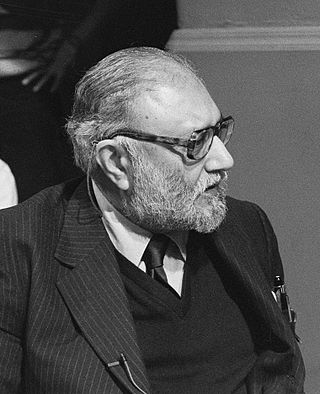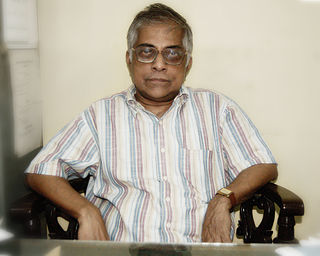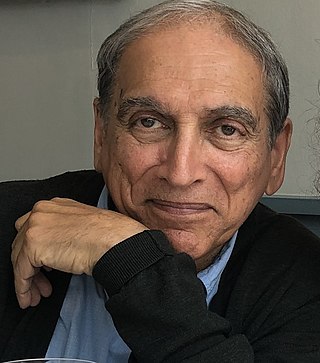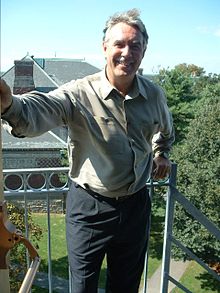
Mohammad Abdus Salam was a Pakistani theoretical physicist and a Nobel Prize laureate. He shared the 1979 Nobel Prize in Physics with Sheldon Glashow and Steven Weinberg for his contribution to the electroweak unification theory. He was the first Pakistani and the first Muslim from an Islamic country to receive a Nobel Prize in science and the second from an Islamic country to receive any Nobel Prize, after Anwar Sadat of Egypt.

Andrew Eben Strominger is an American theoretical physicist who is the director of Harvard's Center for the Fundamental Laws of Nature. He has made significant contributions to quantum gravity and string theory. These include his work on Calabi–Yau compactification and topology change in string theory, and on the stringy origin of black hole entropy. He is a senior fellow at the Society of Fellows, and is the Gwill E. York Professor of Physics.
Jeffrey Goldstone is a British theoretical physicist and an emeritus physics faculty member at the MIT Center for Theoretical Physics.
Daniel Zissel Freedman is an American theoretical physicist. He is an Emeritus Professor of Physics and Applied Mathematics at the Massachusetts Institute of Technology (MIT), and is currently a visiting professor at Stanford University. He is mainly known for his work in supergravity. He is a member of the U. S. National Academy of Sciences.
Sergio Ferrara is an Italian physicist working on theoretical physics of elementary particles and mathematical physics. He is renowned for the discovery of theories introducing supersymmetry as a symmetry of elementary particles and of supergravity, the first significant extension of Einstein's general relativity, based on the principle of "local supersymmetry". He is an emeritus staff member at CERN and a professor emeritus at the University of California, Los Angeles.

Seifallah Randjbar-Daemi is an Iranian theoretical physicist. He is currently an Emeritus Scientist at the International Centre for Theoretical Physics.

David Ian Olive was a British theoretical physicist. Olive made fundamental contributions to string theory and duality theory, he is particularly known for his work on the GSO projection and Montonen–Olive duality.
Paul Kingsley Townsend FRS is a British physicist, currently a Professor of Theoretical Physics in Cambridge University's Department of Applied Mathematics and Theoretical Physics. He is notable for his work on string theory.

Riazuddin, also spelled as Riaz-Ud-Din, was a Pakistani theoretical physicist, specialising in high-energy physics and nuclear physics. Starting his scientific research in physics in 1958, Riazuddin was considered one of the early pioneers of Pakistan's nuclear weapons development and atomic deterrence development. He was the director of the Theoretical Physics Group (TPG) of the Pakistan Atomic Energy Commission (PAEC) from 1974 until 1984. Riazuddin was a pupil of the winner of the 1979 Nobel Prize in Physics, Abdus Salam.

Ghulam Murtaza, SI, FPAS, is a Pakistani theoretical physicist with a specialization in the physics of ionized plasmas, and is an Emeritus Professor of physics at the Government College University in Lahore. Murtaza's work is recognizable in plasma physics and controlled nuclear fusion processes to provide a better understanding of energy propagated by the main-sequence star, the Sun.

The Abdus Salam Centre for Physics, is a federally-funded research institute and national laboratory site managed by the Quaid-i-Azam University for the Ministry of Energy (MoE) of the Government of Pakistan.
Faheem Hussain, was a Pakistani theoretical physicist and a professor of physics at the Lahore University of Management Sciences (LUMS). A research scientist in the field of superstring theory at the National Center for Physics, Hussain made contributions to the fields of superstring and string theory. He was the first Pakistani physicist to publish a research paper in the field of superstring theory. A social activist and democratic activist, he authored various scientific research papers in peer-reviewed journals.
Fayyazuddin, also spelled as Fayyaz Uddin, is a Pakistani theoretical physicist, emeritus professor, specialising in theoretical physics and mathematical physics at Quaid-e-Azam University campus National Centre for Physics, Islamabad. He is a senior scientist at the National Center for Physics. Fayyaz is doing research in the fields of quantum mechanics, particle physics, and meson physics. He has published numerous physics papers accompanied by Riazuddin and has co-authored Quantum Mechanics by Fayyazuddin and Riazuddin published in 1990.
Christopher Michael Hull is a professor of theoretical physics at Imperial College London. Hull is known for his work on string theory, M-theory, and generalized complex structures. Edward Witten drew partially from Hull's work for his development of M-theory.

Amer Iqbal is a Pakistani American theoretical physicist. He is primarily known for his work in string theory and mathematical physics.

Amitava Raychaudhuri is an Indian theoretical particle physicist. He is Professor Emeritus at the Physics Department of the Science College, University of Calcutta where he earlier held the Sir Tarak Nath Palit Chair Professorship. He is the nephew of another renowned Indian physicist, Amal Kumar Raychaudhuri.
Ali H. Chamseddine is a Lebanese physicist known for his contributions to particle physics, general relativity and mathematical physics. As of 2013, Chamseddine is a physics Professor at the American University of Beirut and the Institut des hautes études scientifiques.
Anne-Christine Davis is a British theoretical physicist at the University of Cambridge. She was the first woman to be appointed a professor in the Faculty of Mathematics at the University. Her research mainly concerns cosmology, astrophysics and string theory.
Peter Christopher West, born on 4 December 1951, is a British theoretical physicist at King's College, London and a fellow of the Royal Society.

Qaisar Shafi is a Pakistani-American theoretical physicist and the Inaugural Bartol Research Institute Professor of Physics at the University of Delaware.










